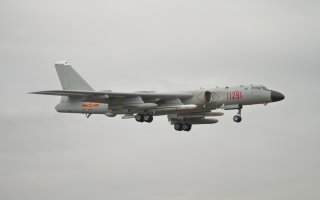Fire! China Wants Its H-6K Bomber To Kill Targets 2,000 Miles Away
The warplane will be armed with hypersonic weapons, according to Chinese media.
Here's What You Need to Know: For now, China is content to project power into its nautical backyard and over adjacent areas.
China’s H-6K may be an old Soviet-designed bomber—but it’s getting twenty-first century missiles.
Chinese H-6Ks—a knockoff of the 1950s Soviet Tu-16 bomber—will be armed with hypersonic weapons, according to Chinese media.
“The warplane could eventually be armed with hypersonic weapons that can destroy hostile military hubs 3,000 kilometers [1,864 miles] away within minutes,” said the Global Times news site. “Together with J-20 stealth fighters, H-6Ks could devastate the enemy's fighting capability even before a war gets fully underway.”
Wang Ya'nan, chief editor of Aerospace Knowledge magazine, told Global Times that while the H-6K is neither fast nor stealthy, it can carry long-range cruise missiles.
“The H-6K can remain within a safe zone, launch its missiles that can reach targets 2,000 kilometers away," Wang said. “With China developing hypersonic weapons [missiles that fly at least five times the speed of sound] in recent years, its attack range and speed could become even greater than a conventional cruise missile, potentially capable of taking out targets deep within hostile territories 3,000 kilometers away within just a few minutes.”
Assuming that each H-6K can carry six missiles, ten bombers can attack as many as sixty vital military hubs, Wang added.
Interestingly, the expert quoted by Chinese media suggested that H-6Ks armed with hypersonic missiles could be paired with J-20 stealth fighters. “The J-20 could partner with the H-6K and clear the sky by shooting down hostile aerial hubs such as early warning aircraft and tanker aircraft, while the H-6K will scorch land hubs such as command centers and missile positions,” Wang told Global Times, which also noted that H-6Ks are already training with unspecified fighters and early warning aircraft.
In effect, China is turning an older bomber into a missile truck. The message seems to be that China would target the ground and air infrastructure that would enable American fighters to project power among the vast Pacific expanses: shooting down early warning planes and aerial tankers, and destroying command centers, would disable U.S. airpower as effectively as destroying U.S. aircraft themselves.
The original Tu-16 (NATO code name “Badger”) debuted in 1954 as a high-altitude, twin-engined Soviet nuclear-armed strategic bomber, and remained in service until 1993 as a versatile bomber, reconnaissance plane and electronic warfare aircraft. With a top speed of around 650 miles per hour—about the same as a B-52—it is a subsonic aircraft that would need fighter and jamming protection to survive in contested skies. China received a license in the late 1950s to build its own Tu-16 as the H-6, which has been heavily upgraded into the H-6K model that features improved engines and electronics.
Yet for an aircraft that is chronologically closer to World War II, China’s almost 150 H-6 bombers are giving the United States and its allies fits today. With a combat radius of around 2,000 miles—roughly the distance between Shanghai and Guam—and capable of being refueled in mid-air, they can reach much of the Western Pacific.
While the H-6K doesn’t have the global legs of a U.S. B-52 bomber, it doesn’t need them. For now, China is content to project power into its nautical backyard and over adjacent areas that it considers crucial, such as the South China Sea, Taiwan and Japan. In turn, that requires an ability to neutralize U.S. forces and bases capable of interfering with, say, an invasion of Taiwan. Hence, Beijing’s new interest in long-range weapons, such as ballistic missiles and missile-armed bombers.
If that strategy is successful, American aircraft could find their airfields have been pounded into rubble. On the other hand, if U.S. fighters like the F-22 and F-35 can get within fifty or one hundred miles of a H-6K—enough to fire an air-to-air missile like the AIM-120—those bomber pilots won’t have a nice day.
Michael Peck is a contributing writer for the National Interest. He can be found on Twitter and Facebook.
This article first appeared in August 2019.
Image: Wikimedia Commons

